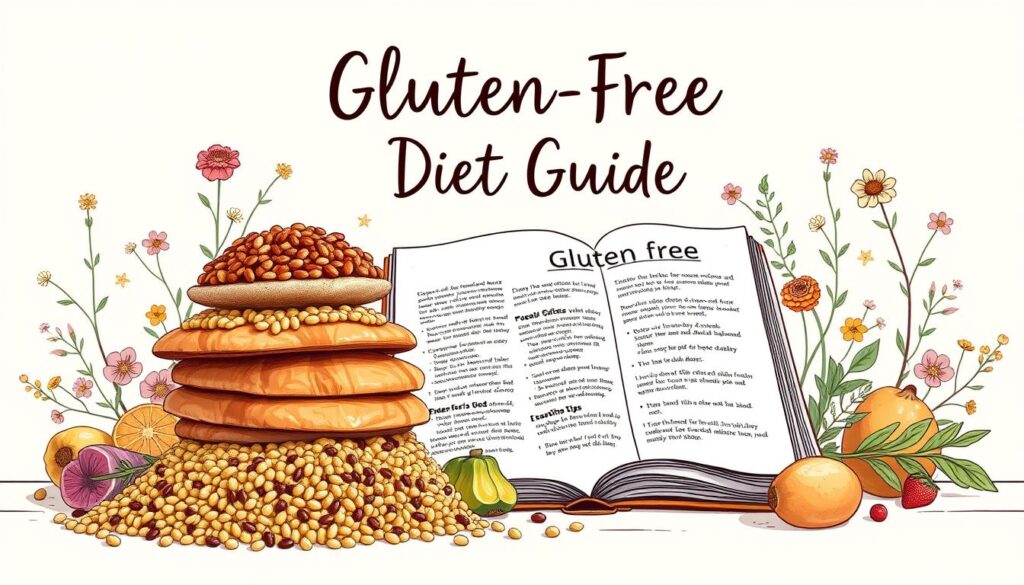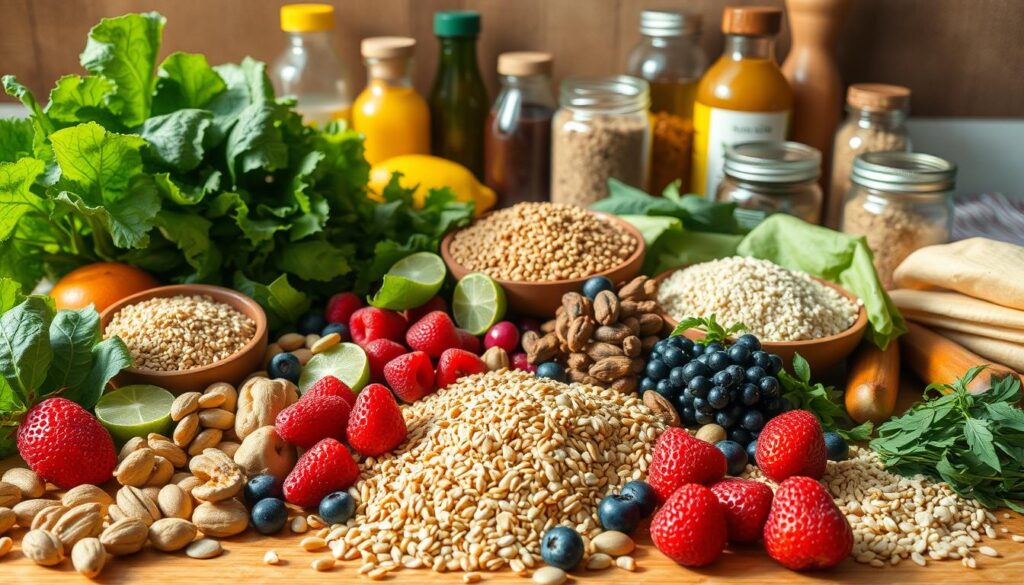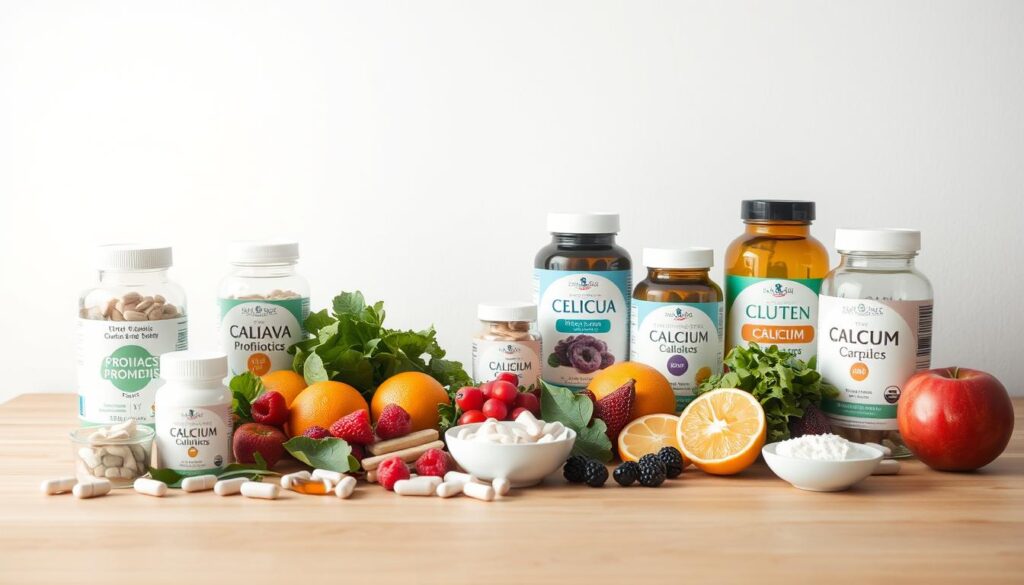Your Guide to a Healthy, Gluten-Free Lifestyle

Table of Contents
Are you thinking about trying a gluten-free diet? It could really change how you feel. About 1% of Americans have celiac disease, and 6% have gluten sensitivity. Knowing about gluten-free living is very important now.
A gluten-free diet means avoiding foods with gluten. Gluten is in wheat, barley, rye, and spelt. It’s not just a trend; it’s needed for some and chosen by others. People with celiac disease must avoid gluten to avoid serious health problems.
Finding gluten-free foods can be hard, but this guide will help. It’s for those with celiac disease or anyone wanting to try a gluten-free lifestyle. Knowing the basics is the first step to success.
Key Takeaways : Gluten-Free
- Gluten-free diets are essential for individuals with celiac disease
- Approximately 6% of people experience gluten sensitivity
- Careful food selection and label reading are crucial
- Nutritional balance is important when eliminating gluten
- Consult healthcare professionals before major dietary changes
Understanding Gluten and Its Effects on Health
Gluten is a complex protein that affects many people’s health. It comes from the Latin word for “glue.” This protein makes bread chewy and helps dough keep its shape.
For those who need a wheat-free diet, knowing about gluten is key. It’s mainly in wheat, barley, and rye. These are common in many processed foods.
What is Gluten and Where is it Found?
- Common sources of gluten include:
- Bread and baked goods
- Pasta
- Cereals
- Beer
- Soy sauce
Common Symptoms of Gluten Sensitivity
About 6-7% of people have gluten sensitivity. Symptoms include:
- Bloating and gas
- Abdominal pain
- Headaches
- Fatigue
- Skin problems
Health Conditions Related to Gluten
1 in 133 Americans has celiac disease. It’s an autoimmune disorder caused by gluten. If not treated, it can harm your digestive health.
“Understanding your body’s response to gluten is key to maintaining optimal health and wellness.” – Nutrition Expert
Most celiac disease cases go undiagnosed. If you have ongoing digestive issues, see a doctor.
Why People Choose a Gluten-Free Diet
Many people choose a gluten-free diet for personal or health reasons. About 1 in 100 people worldwide have celiac disease, which means they must avoid gluten. Gluten intolerance is also a big health issue, leading many to change their diet.
There are several reasons why people go gluten-free:
- Medical need due to celiac disease
- Non-celiac gluten sensitivity
- Potential health benefits
- Weight loss goals
Studies show that 6-7% of Americans might have gluten sensitivity. Lifestyle change to gluten-free eating is becoming more popular. About 30% of people without gluten-related conditions are choosing this diet.
| Motivation | Percentage |
|---|---|
| Celiac Disease | 1% |
| Non-Celiac Sensitivity | 6-7% |
| Personal Health Choice | 30% |
But, there are things to watch out for. Gluten-free processed foods can be pricey and might not be as healthy. It’s important to talk to a doctor before making big changes to your diet to make sure you get all the nutrients you need.
Essential Foods to Avoid on a Gluten-Free Diet
Living without grains means being very careful about what you eat. It’s important to know where gluten hides to stay healthy and avoid health problems.
Hidden Sources of Gluten
Gluten is found in many places you might not expect. Nutrition labels are your key to avoiding it. About 20 million Americans avoid gluten because of its health risks.
- Processed snack foods
- Sauces and gravies
- Marinades and salad dressings
- Imitation meats
- Beer and malt beverages
Common Products Containing Gluten
Many foods we eat every day have gluten, making it hard to choose what to eat. The FDA says foods labeled gluten-free must have less than 20 parts per million (ppm) of gluten.
- Bread and baked goods
- Pasta
- Breakfast cereals
- Crackers
- Packaged convenience foods
Cross-Contamination Risks
Even foods that are naturally gluten-free can get contaminated. For example, up to 90% of oat products may have gluten unless they’re labeled gluten-free.
Always read nutrition labels carefully and choose certified gluten-free products to minimize health risks.
Knowing where gluten might be helps you make better food choices. This way, you can keep your diet healthy and grain-free.
Naturally Gluten-Free Foods and Ingredients

Understanding the many gluten-free foods makes it easier to keep your digestive health in check. There are lots of tasty and healthy options for those on a gluten-free diet.
Whole foods are a great start for a gluten-free lifestyle. Here are some safe and healthy alternatives for those avoiding gluten:
- Fresh Fruits and Vegetables: 100% naturally gluten-free
- Proteins:
- Fresh meats
- Poultry
- Fish
- Eggs
- Legumes
- Nuts and seeds
- Dairy Products: Most unflavored options
Gluten-free whole grains are great for those looking for grain-based foods. Here are some top picks:
- Quinoa
- Brown rice
- Wild rice
- Buckwheat
- Millet
- Amaranth
- Teff
When choosing processed foods, it’s important to read labels carefully. Some products might have hidden gluten. Always check the ingredient list to keep your diet gluten-free and support your digestive health.
Remember: Fresh, whole foods are your safest bet for a gluten-free lifestyle.
There are many drink options for those avoiding gluten. Safe choices include water, 100% fruit juices, coffee, tea, and some alcoholic drinks like wine and gluten-free beer.
Reading Labels and Shopping Smart
Understanding nutrition labels is key for those on a gluten-free diet. The FDA has clear guidelines to help you choose gluten-free products wisely. This ensures a safe and healthy lifestyle.
Understanding Certification Labels
When you’re shopping for gluten-free items, look for these labels:
- Certified Gluten-Free logo
- GFCO (Gluten-Free Certification Organization) symbol
- FDA-approved gluten-free label
“In the United States, foods labeled gluten-free must contain less than 20 parts per million of gluten.”
Smart Shopping Tips for Gluten-Free Products
Shopping for gluten-free items requires careful label reading. Here are some tips to keep you safe:
- Read labels every time you buy a product
- Check for hidden gluten sources
- Look for certified gluten-free products
| Gluten-Containing Ingredients | Safe Alternatives |
|---|---|
| Wheat | Rice flour |
| Barley | Quinoa |
| Rye | Corn flour |
Budget-Friendly Shopping Strategies
Gluten-free living doesn’t have to be expensive. Buy in bulk, choose store brands, and watch for sales. Many stores now offer affordable gluten-free options. This makes sticking to a gluten-free diet easier and more affordable.
Nutritional Considerations and Supplements

Managing celiac disease means paying close attention to what you eat. Studies show that people with this condition often struggle to get enough nutrients. Gluten can harm the small intestine, leading to a lack of important vitamins and minerals.
Those with celiac disease often have trouble absorbing nutrients. Important things to consider include:
- Iron deficiency affecting about 50% of patients
- Challenges with calcium and vitamin D absorption
- Potential protein intake limitations
- Risk of fiber deficiency
Healthcare experts suggest supplements to fill these nutritional gaps. Seeing a registered dietitian who knows about celiac disease can help create a diet plan just for you.
Some supplements that might be recommended are:
- Multivitamin made for celiac patients
- Iron supplements
- Calcium with vitamin D
- Vitamin B12
- Zinc
It’s important to see your doctor regularly to check on your nutrition. The American College of Gastroenterology says it’s key to do nutritional checks to catch any shortages early and adjust your diet.
Proper nutrition management is key to thriving with celiac disease.
Dining Out and Social Situations
Dealing with gluten intolerance in social situations can be tough. But, with the right approach, you can handle it well. Knowing how to eat out and attend social events is key to keeping your health and staying connected with friends.
When eating out, planning and talking to the restaurant are important. Today, 80% of restaurants offer gluten-free choices. This makes it easier for those with dietary needs to enjoy meals out.
Restaurant Navigation Tips
- Call ahead to discuss gluten-free menu options
- Ask detailed questions about food preparation
- Request to speak with the chef about cross-contamination risks
- Verify ingredients and cooking methods
Handling Social Events
Social events can be stressful for those with gluten intolerance. 67% of individuals with dietary restrictions report feeling anxious about dining out. Talking openly about your needs helps a lot.
- Inform hosts about your dietary needs in advance
- Offer to bring a gluten-free dish to share
- Eat before the event if necessary
- Focus on socializing rather than food limitations
Travel Strategies
Traveling with gluten intolerance needs planning. About 78% of travelers use apps or websites to find gluten-free places to eat.
| Travel Preparation Strategy | Success Rate |
|---|---|
| Research destination restaurants | 85% |
| Pack gluten-free snacks | 75% |
| Book accommodations with kitchen facilities | 50% |
“Confidence comes from being prepared and knowing how to advocate for your dietary needs.” – Nutrition Expert
By using these tips, people with gluten intolerance can enjoy dining out and social events. They can stay healthy and have fun with friends.
Kitchen Organization and Meal Planning
Setting up a safe and efficient wheat-free kitchen needs careful planning. It’s especially important for those with gluten sensitivity to avoid cross-contamination.
Here are key strategies for a gluten-free kitchen:
- Have separate spots for gluten-free and gluten products
- Use color-coded cutting boards and utensils for gluten-free cooking
- Clean surfaces well to remove gluten traces
- Get dedicated substitutes for shared kitchen tools
Studies show up to 30% of gluten-sensitive people face cross-contamination in shared kitchens. To lower risks, try these tips:
- Keep gluten-free items on top fridge shelves
- Use separate toaster ovens for gluten-free bread
- Change kitchen sponges every day
- Make sure to label storage containers
A well-organized gluten-free kitchen is not just about separation—it’s about creating a safe and welcoming cooking environment.
Meal planning is key for a wheat-free diet. Batch cooking and freezing gluten-free meals can save time and reduce stress. Look for versatile recipes that fit gluten-free needs.
With the right organization and strategy, managing a gluten-free kitchen becomes easy. It ensures safety and delicious meals.
Conclusion
Living gluten-free is more than just a diet choice. It’s a big change in lifestyle that needs careful thought and planning. With up to 30% of adults in the U.S. looking to cut down on gluten, it’s key to understand food allergies well.
Getting advice from healthcare experts is vital for those with celiac disease or gluten sensitivity. About 1% of Americans have celiac disease, and another 6-7% might have gluten sensitivity. This shows how important it is to get personalized diet advice and plan meals wisely.
Gluten-free living is all about eating whole, naturally gluten-free foods and choosing products carefully. The FDA’s strict rules for gluten-free labels help keep consumers safe. By picking nutrient-rich foods and knowing where gluten might hide, you can make a diet that’s both healthy and enjoyable.
In the end, a gluten-free life is about feeling empowered, healthy, and finding tasty foods that are good for you. With the right knowledge, preparation, and attitude, anyone can do well on this dietary path.
FAQ
What exactly is gluten and why do some people need to avoid it?
Gluten is a protein in wheat, barley, and rye. It can harm people with celiac disease or gluten sensitivity. For them, eating gluten can damage the small intestine and cause digestive problems.
How do I know if I have celiac disease or gluten intolerance?
You need a doctor’s test, like blood tests or an intestinal biopsy, to find out. Symptoms include stomach problems, tiredness, weight loss, bloating, and skin rashes. See a gastroenterologist or dietitian for a proper diagnosis.
What foods should I absolutely avoid on a gluten-free diet?
Stay away from wheat products like bread, pasta, and baked goods. Watch out for hidden gluten in soy sauce, marinades, processed meats, and some meds. Always check labels for gluten-free products.
Are oats gluten-free?
Pure oats are gluten-free. But most commercial oats are processed with wheat, risking contamination. Choose certified gluten-free oats to be safe.
Can I get enough nutrients on a gluten-free diet?
Yes, with the right planning, a gluten-free diet can be complete. Eat whole foods like fruits, veggies, lean proteins, and gluten-free grains like quinoa and rice. A nutritionist can help ensure you get all the nutrients you need.
How can I eat out safely with a gluten-free diet?
Tell the restaurant staff about your dietary needs. Look at menus online and ask about how food is prepared. Many places now offer gluten-free options and know how to handle dietary restrictions.
Is a gluten-free diet helpful for weight loss?
A gluten-free diet isn’t a weight loss plan. Some might lose weight by avoiding processed wheat, but it’s about eating balanced and not just cutting out gluten. Losing weight is about calorie intake and nutrition.
What are the best gluten-free grain alternatives?
Good alternatives include quinoa, rice, millet, buckwheat, amaranth, and corn. These grains are nutritious and can replace wheat in many recipes.
How expensive is maintaining a gluten-free diet?
Gluten-free products cost more than regular ones. To save money, eat whole, naturally gluten-free foods, buy in bulk, and use generic brands. Making meals from scratch can also help.
Can children follow a gluten-free diet safely?
Yes, kids can safely follow a gluten-free diet with the right nutrition. A pediatric nutritionist can help ensure the diet supports growth and development. There are many gluten-free options and recipes for kids.

